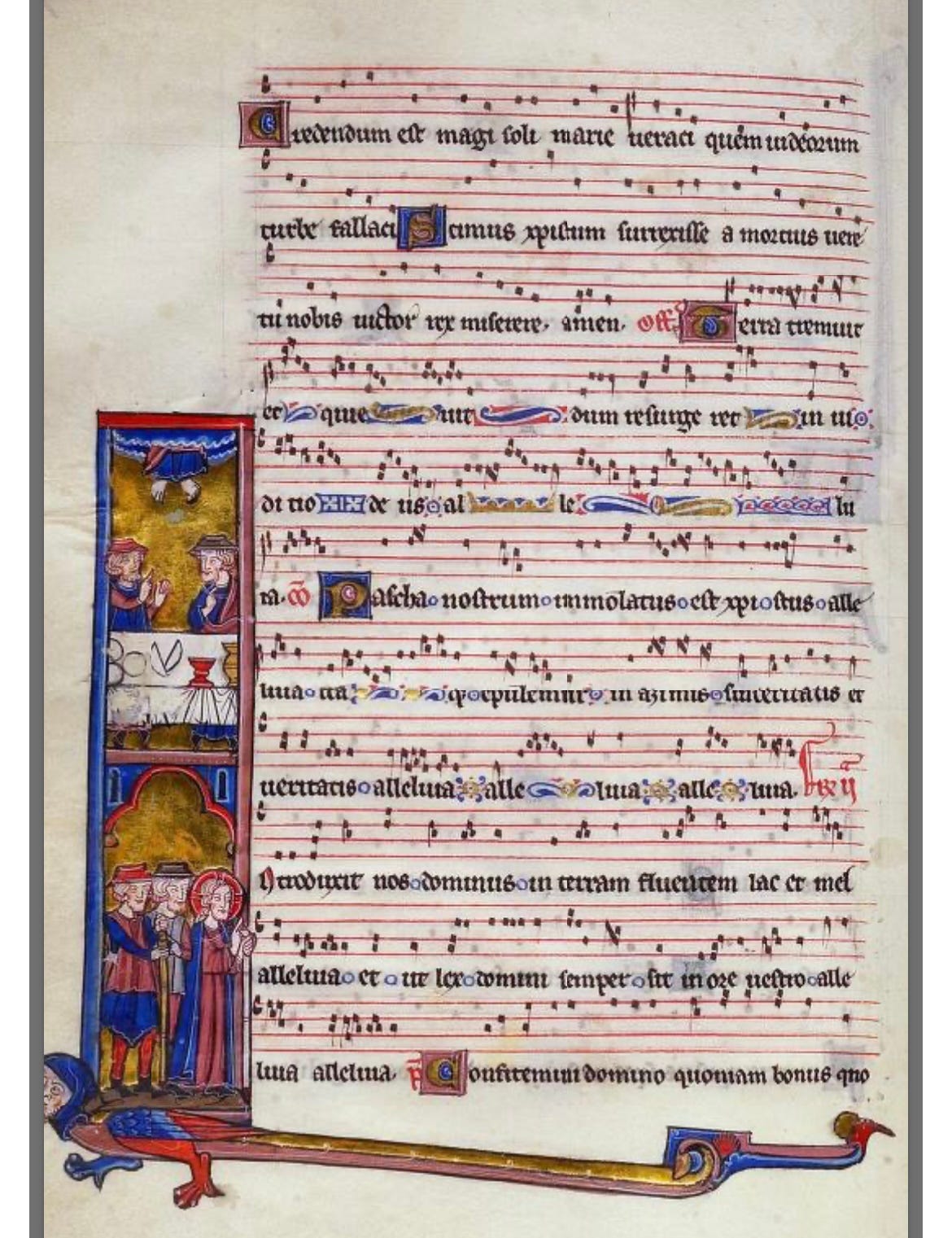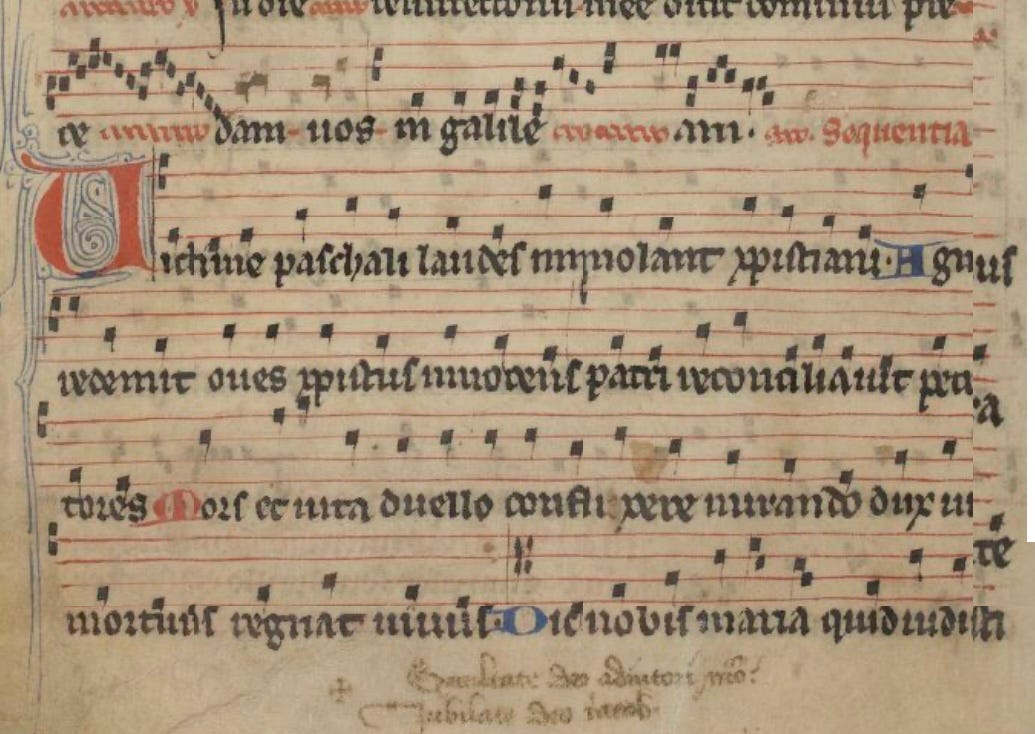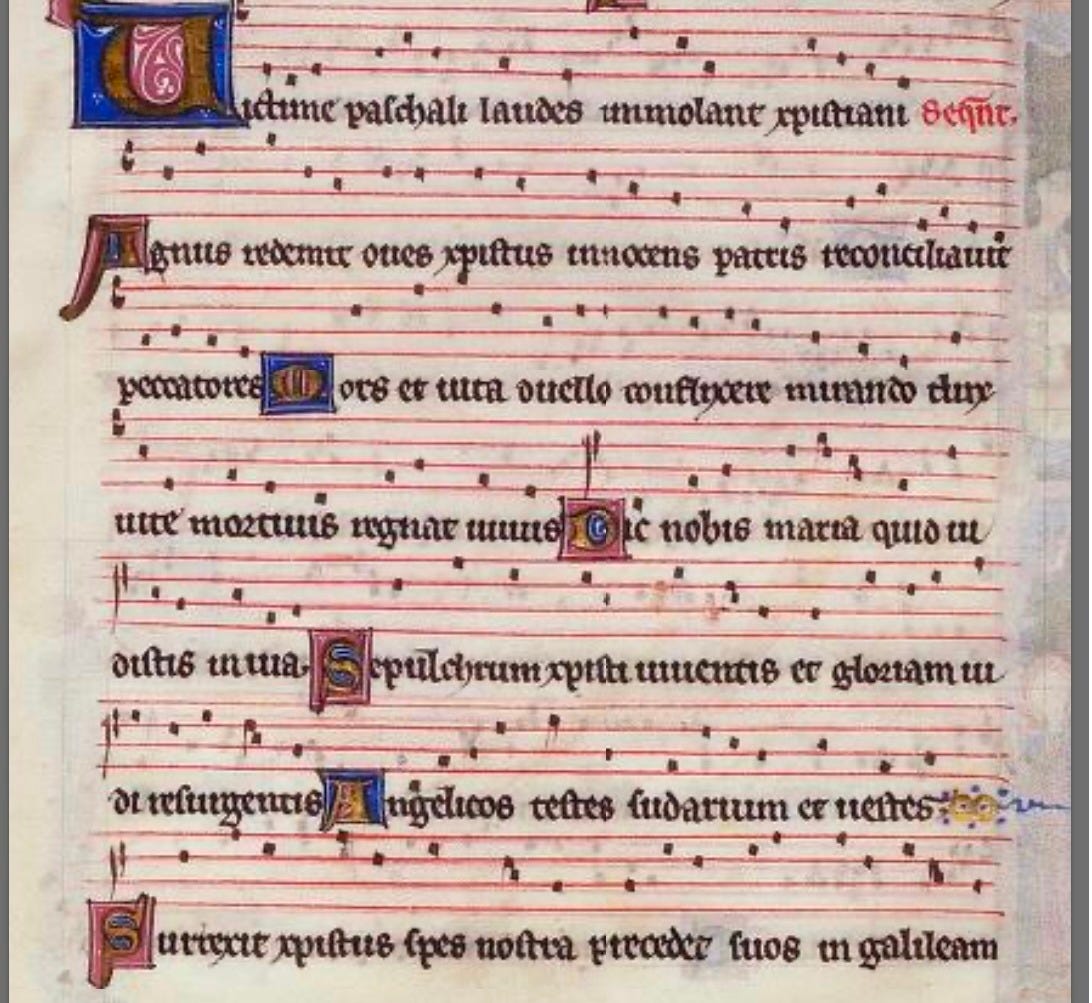
Victimae paschali laudes
immolent Christiani.
Agnus redemit oves:
Christus innocens Patri
reconciliavit peccatores.
Christians, to the Paschal victim
Offer your thankful praises!
A Lamb the sheep redeemeth:
Christ, who only is sinless,
Reconcileth sinners to the Father.
I remember the first time I heard the Victimae Paschali Laudes sung in Latin. I must admit it was not very long ago. During the early days of Covid, when churches were shut down, even for Easter, some of my former roommates and I would sometimes pray the Divine Office together. They had grown up doing this and knew all the Marian Antiphons and many of the chants of the Church. I did not grow up hearing this music and was eager to learn from them. During Bright Week they sang the Victimae Paschali Laudes, the ancient Easter sequence, composed to be sung after the Alleluia and before the Gospel. Upon hearing it, I was immediately struck by the beauty of the poetry, the music, and the immense significance of Christ’s Resurrection.
Of course, I had heard the sequence on Easter in English before this, but the English did not pierce my memory in the same way. Although the English translation still retains the drama of the Gospel story, much of the rich poetry, which helps this drama sink into our hearts and memories, is lost in translation.1
It is worth singing or listening to the Latin at home with family, even if you are not able to hear it at Mass. I will weave the text into this article, but if you would like to read it first, you can see the footnote below. I have also included a couple of video versions at the end.2
Mors et vita duello
conflixere mirando:
dux vitae mortuus,
regnat vivus.
Death and life have contended
in that combat stupendous:
the Prince of life, who died,
reigns immortal.
The short sequence unfolds like a gentle secret, softly at first, in low whispers and then in joyous, humble yet confident tones. It captures both the mystery and the gravity of the Resurrection. Many great musicians including the likes of Palestrina, William Bird, and Hans Buchner, have written melodies for it, but the simple chant alone is magnificent.
Richard Clark summarizes the story of the sequence well,
This ancient hymn tells the story of death and life locked in a struggle, wherein Christ, the Paschal victim, victorious over death, reconciles us to the Father. It tells the story of Mary Magdalene, who upon finding the empty tomb of the risen Christ and of finding the clothes which once covered his head and limbs, proclaims “Christ my hope has arisen.3
Dic nobis Maria,
quid vidisti in via?
“Sepulcrum Christi viventis,
et gloriam vidi resurgentis…”
Speak, Mary, declaring
what thou sawest, wayfaring:
“The tomb of Christ, who is living,
the glory of Jesus’ resurrection…”
While researching the Victimae Paschali Laudes, I happened upon the Cantus Index and found some extraordinary manuscripts of the sequence, many of which are from the eleventh century.4 The index includes 167 manuscripts which contain the ancient hymn, many of which have been fully digitized.
As this sequence celebrates the Resurrection, the initials of these manuscripts are fittingly clothed with elaborate designs. It’s amazing to see how much of the music has been retained over the span of almost one thousand years.5
The sequence is one of only four retained in the Roman Missal after 1570. By the twelfth century, the Victimae Paschali Laudes was already widespread throughout Europe, and it has been used liturgically on Easter and during Bright Week ever since.6 Over the centuries, it has been attributed to many authors, such as Robert II and Adam of St Victor; however, many of the hymn’s manuscripts predate these two authors, and so now it is ascribed to Wipo of Burgundy (d. 1048), a priest and chaplain to the Holy Roman Emperor Conrad II.
Angelicos testes,
sudarium, et vestes.
Surrexit Christus spes mea:
praecedet suos in Galilaeam.
“Bright angels attesting,
the shroud and napkin resting.
“Yea, Christ my hope is arisen;
to Galilee he goes before you.”

Of the music, Athelston Riley says, “the composition is made up of successive musical phrases repeated, that the sequence consists of parallel lines, or stanzas often varying in length.”7
He goes on to describe the liturgical ceremony the sequence was used in during the Middle Ages, when the Eucharist was taken from the chapel it was placed in on Maundy Thursday back into the church.
This sequence was introduced into the Quem Quaeritis when so sung the whole formed a little sacred opera after the Third Nocturn at Matins, concluding With the Te Deum. Three boys, dressed in albes with amices over their heads, represented the three Maries, and as they advanced up the choir the precenter would ask, “Dic nobis Maria, quid vidisti in via?" ("Speak, Mary, declaring, etc.") Then they would reply, “Sepulchrum Christi, etc."
From this tiny seed, and not from the classical stage which had perished centuries before… has grown the drama of today; first the miracle plays, then the moralities, such as Everyman.
“From here,” he writes, “it is only a short step” to Marlowe and Shakespeare. Although only sung for a short time every year, the Victimae Paschali Laudes is an unforgettable hymn that has also left an immeasurable mark on culture. Without Christ and the Mass, the best of Western art, theatre, and music would be inconceivable.
Scimus Christum surrexisse
a mortuis vere:
tu nobis, victor Rex, miserere.
Amen. Alleluia!
Christ indeed from death is risen,
our new life obtaining;
have mercy, victor King,
ever reigning!
Amen. Alleluia!

Listen to the chant:
With organ arrangement by Pierre Cochereau:
Simple chant with music:
Dr. Foley has an excellent article on the sequence at NLM: https://www.newliturgicalmovement.org/2021/04/the-easter-sequence-victimae-paschali_01217123189.html?m=1
Victimae paschali laudes
immolent Christiani.
Agnus redemit oves:
Christus innocens Patri
Reconciliavit peccatores.
Mors et vita duello conflixere mirando,
Dux vitae mortuus, regnat vivus.
Dic nobis Maria, quid vidisti in via?
Sepulcrum Christi viventis,
Et gloriam vidi resurgentis:
Angelicos testes, sudarium et vestes.
Surrexit Christus spes mea:
Praecedet vos in Galilaeam.
Credendum est magis soli
Mariae veraci
Quam Judaeorum
Turbae fallaci.
Scimus Christum surrexisse
a mortuis vere:
Tu nobis, victor Rex, miserere.
Amen. Alleluia.
Christians, to the Paschal victim
Offer your thankful praises!
A Lamb the sheep redeems:
Christ, who only is sinless,
Reconciles sinners to the Father.
Death and life have contended
in that combat stupendous:
The Prince of life, who died,
reigns immortal.
Speak, Mary, declaring
What you saw, wayfaring.
"The tomb of Christ, who is living,
the glory of Jesus' resurrection;
"Bright angels attesting,
The shroud and napkin resting.
"Yes, Christ my hope is arisen;
To Galilee he goes before you."
Christ indeed
from death is risen,
our new life obtaining.
Have mercy, victor King,
ever reigning!
Amen. Alleluia!
See PDF with translation: https://archive.ccwatershed.org/media/pdfs/16/03/31/09-04-39_0.pdf
https://www.ccwatershed.org/2016/03/31/sequence-during-octave-easter/
“Cantus Index is 1) a catalogue of chant texts and melodies for the liturgical Office and Mass,and 2) a federated search of online chant resources. Through the use of unique "Cantus IDs," multiple online medieval music databases have been networked together in order that chant texts and melodies can be searched on this Cantus Index website and matches in all of the partner databases will be returned.”
https://cantusindex.org/
One verse about the Jews was omitted in 1570.
browse the manuscripts: https://cantusindex.org/id/ah54007
https://archive.org/details/concerninghymntu00rileuoft









Thanks for taking us from Palm Sunday through Easter!
Another lovely spotlight!
When I truly *heard* this sequence for the first time, the image I saw in my mind's eye was stopping Mary as she ran along the way, seeing her turn to me with bright, wide eyes filled with tears, and hearing her say, "Christ my hope is risen!" Ahhh..! It resonates so powerfully in my heart.